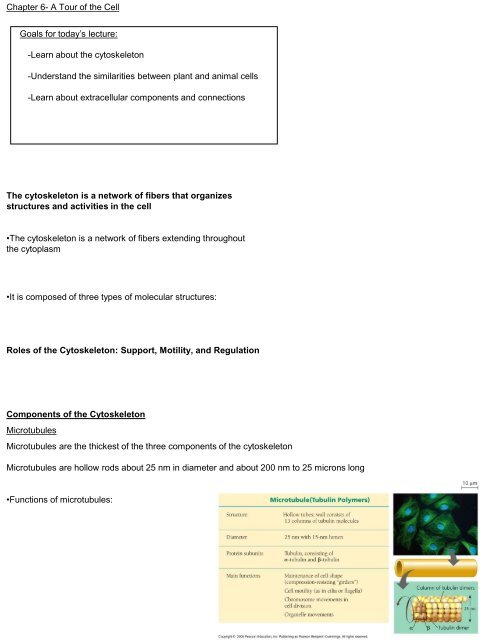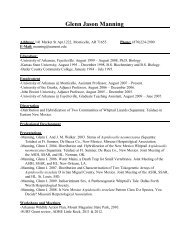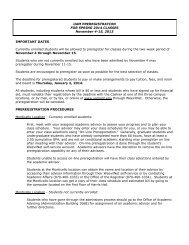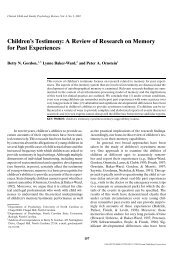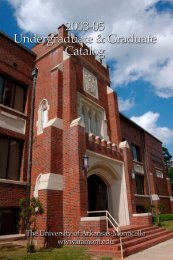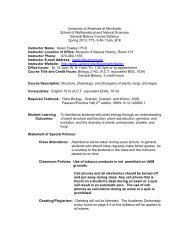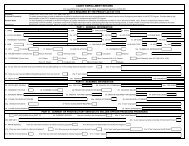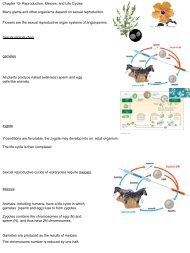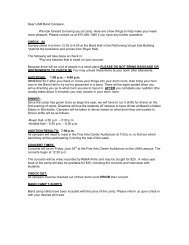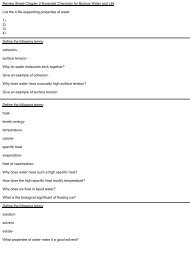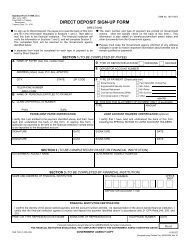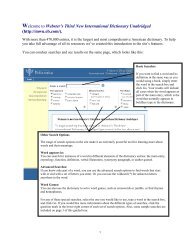A Tour of the Cell
A Tour of the Cell
A Tour of the Cell
You also want an ePaper? Increase the reach of your titles
YUMPU automatically turns print PDFs into web optimized ePapers that Google loves.
Centrosomes and CentriolesFlagellumENDOPLASMIC RETICULUM (ERRough ERSmooth ERNuclear envelopeNucleolusNUCLEUSChromatin•In many cells, microtubules grow out from acentrosome near <strong>the</strong> nucleusCentrosomePlasma membraneThe centrosomeCYTOSKELETONMicr<strong>of</strong>ilamentsIntermediate filamentsMicrotubulesRibosomes:In animal cells, <strong>the</strong> centrosome has a pair <strong>of</strong> centrioles,MicrovilliGolgi apparatusPeroxisomeMitochondrionLysosomeIn animal cells but not plant cells:LysosomesCentriolesFlagella (in some plant sperm)Cilia and FlagellaCentrosomeMicrotubules control <strong>the</strong> beating <strong>of</strong> cilia andflagella, locomotor appendages <strong>of</strong> some cellsCilia and flagella differ in <strong>the</strong>ir beating patternsCentriolesMicrotubuleMotion <strong>of</strong> flagellaDirection <strong>of</strong> organism’s movementLongitudinal section<strong>of</strong> one centrioleMicrotubulesCross section<strong>of</strong> <strong>the</strong> o<strong>the</strong>r centrioleDirection <strong>of</strong>active strokeDirection <strong>of</strong>recovery stroke•Cilia and flagella share a common ultrastructure:A core <strong>of</strong> microtubulesA basal bodyMotion <strong>of</strong> ciliaA motor protein called dynein, which drives<strong>the</strong> bending movements <strong>of</strong> a cilium orflagellumMicrotubulesPlasmamembraneBasal bodyCross section <strong>of</strong> basal body
Components <strong>of</strong> <strong>the</strong> CytoskeletonMicr<strong>of</strong>ilaments•Micr<strong>of</strong>ilaments are solid rods about 7 nmin diameter, built as a twisted double chain<strong>of</strong> actin subunitsMicr<strong>of</strong>ilaments (Actin Filaments)•The structural role <strong>of</strong> micr<strong>of</strong>ilaments is toMicrovillus•Bundles <strong>of</strong> micr<strong>of</strong>ilaments make up <strong>the</strong> core <strong>of</strong>microvilli <strong>of</strong> intestinal cellsPlasma membraneMicr<strong>of</strong>ilaments (actinfilaments)•In muscle cells, thousands <strong>of</strong> actin filaments arearranged parallel to one ano<strong>the</strong>rIntermediate filaments•Thicker filaments composed <strong>of</strong> myosin interdigitate with<strong>the</strong> thinner actin fibersMuscle cellActin filamentMyosin filamentMyosin arm•Pseudopodia (cellular extensions) extend andcontract through <strong>the</strong> reversible assembly andcontraction <strong>of</strong> actin subunits into micr<strong>of</strong>ilamentsCytoplasmic streamingExtendingpseudopodiumMyosin motors in muscle cell contractionInner cytoplasm: solwith actin subunitsCortex (outer cytoplasm):gel with actin networkThis streaming speeds distribution <strong>of</strong> materials within <strong>the</strong> cellAmoeboid movementNonmovingcytoplasm (gel)ChloroplastStreamingcytoplasm(sol)VacuoleParallel actinfilaments<strong>Cell</strong> wallCytoplasmic streaming in plant cells
Components <strong>of</strong> <strong>the</strong> CytoskeletonIntermediate Filaments•Intermediate filaments range in diameter from 8–12nanometers, larger than micr<strong>of</strong>ilaments but smaller thanmicrotubules•They support cell shape and fix organelles in placeExtracellular components and connections between cellshelp coordinate cellular activities•Most cells syn<strong>the</strong>size and secrete materials that are external to <strong>the</strong> plasma membrane•These extracellular structures include:<strong>Cell</strong> Walls <strong>of</strong> PlantsThe cell wall is an extracellular structure thatdistinguishes plant cells from animal cells•Plant cell walls may have multiple layers:–Primary cell wall:Centralvacuole<strong>of</strong> cellPlasmamembraneSecondarycell wallPrimarycell wall–Middle lamella:Centralvacuole<strong>of</strong> cellMiddlelamella–Secondary cell wall (in some cells:Central vacuole1 µmCytosolPlasma membranePlant cell wallsPlants: PlasmodesmataPlasmodesmata<strong>Cell</strong> wallsInterior<strong>of</strong> cell•Through plasmodesmata, water and small solutes (andsometimes proteins and RNA) can pass from cell to cellInterior<strong>of</strong> cellPlasmodesmataPlasma membranes
The Extracellular Matrix (ECM) <strong>of</strong> Animal <strong>Cell</strong>s•Functions <strong>of</strong> <strong>the</strong> ECM:Intercellular Junctions•Neighboring cells in tissues, organs, or organ systems<strong>of</strong>ten adhere, interact, and communicate through directphysical contact•Intercellular junctions facilitate this contactAnimals: Tight Junctions, Desmosomes, and Gap JunctionsTight junctions preventfluid from movingacross a layer <strong>of</strong> cellsTight junction•DesmosomesTight junction•Gap junctionstight junctionsSpacebetweencellsDesmosomeGapjunctionsGap junctionExtracellularmatrix
Study outline-Chapter 6-A <strong>Tour</strong> <strong>of</strong> <strong>the</strong> <strong>Cell</strong>-Understand <strong>the</strong> structure and function <strong>of</strong> <strong>the</strong> cytoskeleton-Know three types <strong>of</strong> fibers <strong>of</strong> <strong>the</strong> cytoskeleton: microtubules, micr<strong>of</strong>ilaments, intermediate filaments-Understand <strong>the</strong> structure <strong>of</strong> centrosomes and centrioles-Know <strong>the</strong> structure and function <strong>of</strong> cilia and flagella (Fig. 6.24)-Understand movement <strong>of</strong> cytoplasmic streaming and amoeboid movement-Know terms-cytoskeleton, microtubule, micr<strong>of</strong>ilament, intermediate fibers, centrosomes, centriole, cilia, flagella,dynein, basal body, myosin, actin, amoeboid movement, pseudopodia, cytoplasmic streaming-Understand extracellular components and connections-Know and recognize plant cell walls, extracellular matrix <strong>of</strong> animal cells and intracellular junctions-Understand structure <strong>of</strong> plant cell walls (primary, secondary, and middle lamellae) and plamodesmata.-Understand and recognize components and functions <strong>of</strong> extracellular matrix <strong>of</strong> animal cells-Know <strong>the</strong> structure and function <strong>of</strong> intercellular junctions-tight junctions, desmosomes, and gap junctions-Understand differences between plant and animal cells


